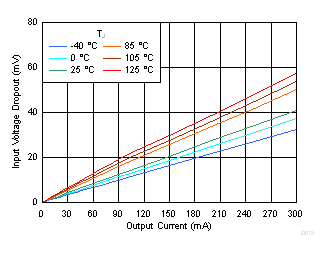-
TPS7A10 300-mA, Low VIN, Low VOUT, Ultra-Low Dropout Regulator
- 1 Features
- 2 Applications
- 3 Description
- 4 Revision History
- 5 Pin Configuration and Functions
- 6 Specifications
- 7 Detailed Description
-
8 Application and Implementation
- 8.1 Application Information
- 8.2 Typical Application
- 9 Power Supply Recommendations
- 10Layout
- 11Device and Documentation Support
- 12Mechanical, Packaging, and Orderable Information
- IMPORTANT NOTICE
Package Options
Refer to the PDF data sheet for device specific package drawings
Mechanical Data (Package|Pins)
- DSE|6
- YKA|5
Thermal pad, mechanical data (Package|Pins)
Orderable Information
TPS7A10 300-mA, Low VIN, Low VOUT, Ultra-Low Dropout Regulator
1 Features
- Ultra-Low Input Voltage Range: 0.75 V to 3.3 V
- Ultra-Low Dropout for Minimum Power Loss:
- Low Quiescent Current:
- VIN IQ = 1.6 µA (Typical)
- VBIAS IQ = 6 µA (Typical)
- 1.5% Accuracy over Load, Line, and Temperature
- High PSRR: 60 dB at 1 kHz
- Available in Fixed-Output Voltages:
- 0.5 V to 3.0 V (in 50-mV Steps)
- VBIAS Range: 1.7 V to 5.5 V
- Packages:
- 0.74-mm × 1.09-mm WCSP-5
- 1.50-mm × 1.50-mm WSON-6
- Built-In Soft Start With Monotonic VOUT Rise
- Active Output Discharge
2 Applications
- Smart Watch, Fitness Trackers
- Wireless Headphones and Earbuds
- Camera Modules
- Smart Phones and Tablets
- Portable Medical Devices
3 Description
The TPS7A10 is an ultra-small, low quiescent current, low-dropout regulator (LDO) that can source 300 mA with an outstanding ac performance (load and line transient responses). This device has an input range of 0.75 V to 3.3 V, and output range of 0.5 V to 3.0 V with a very high accuracy of 1.5% over load, line and temperature. This performance is ideal for powering the lower core voltages of the modern MCUs and analog sensors.
The main power path is through VIN and can be connected to a power supply as low as 70 mV above the output voltage. This device supports very low input voltages with the use of an additional VBIAS rail that is used to power the internal circuitry of the LDO. Both VIN and VBIAS consume very low quiescent current of 1.6 µA and 6 µA, respectively. The low IQ and ultra-low dropout features helps in increasing the efficiency of the solution in the power-sensitive applications. For example, VIN can be an output of a high-efficiency, DC/DC step-down regulator, and the VBIAS pin can be connected to a rechargeable battery.
The TPS7A10 is equipped with an active pull-down circuit to quickly discharge the output when disabled, and provides a known start-up state.
The TPS7A10 is available in an ultra-small, 5-pin DSBGA (YKA) package that makes the device suitable for space-constrained applications. The device is also available in a 6-pin WSON (DSE) package.
Device Information(1)
| PART NUMBER | PACKAGE | BODY SIZE (NOM) |
|---|---|---|
| TPS7A10 | WSON (6) | 1.50 mm × 1.50 mm |
| DSBGA (5) | 0.74 mm × 1.09 mm (0.35-mm pitch) |
- For all available packages, see the package option addendum at the end of the data sheet.
4 Revision History
Changes from A Revision (June 2018) to B Revision
- Added YKA Package to sub-bullet of Ultra-Low Dropout for Minimum Power Loss bullet in FeaturesGo
- Added last sentence to Description section Go
- Changed WSON (DSE) package from Advanced Information to Production Data (active)Go
- Added YKA Package to title of Dropout vs IOUT and Temperature, YKA Package figureGo
- Added YKA Package to captions of Output Accuracy Over Temperature, YKA Package and Output Accuracy Over Temperature, YKA Package figuresGo
- Added Output Accuracy Over Temperature, DSE Package and Output Accuracy Over Temperature, DSE Package figuresGo
- Added YKA Package to caption of Dropout vs IIOUT and Temperature, YKA Package figureGo
- Added Dropout vs IIOUT and Temperature, DSE Package figure Go
Changes from * Revision (March 2018) to A Revision
- Changed from Advanced Information to Production Data (active)Go
5 Pin Configuration and Functions
Pin Functions
| PIN | I/O | DESCRIPTION | ||
|---|---|---|---|---|
| NAME | DSE | YKA | ||
| IN | 6 | A1 | I | Input pin. For best transient response and to minimize input impedance, use the recommended or larger value ceramic capacitor from IN to ground. as listed in the Recommended Operation Conditions. Place the input capacitor as close as possible to input of the device. |
| OUT | 1 | A3 | O | Regulated output pin. A capacitor is required from OUT to ground for stability. For best transient response, use larger than the minimum recommended value ceramic capacitor. Follow the recommended capacitor value as listed in the Recommended Operation Conditions. Place the output capacitor as close as possible to output of the device. |
| GND | 5 | B2 | — | Ground pin. This pin must be connected to ground. |
| BIAS | 4 | C1 | I | BIAS pin. This pin enables the use of low-input voltage, low-output voltage conditions, (LILO). For best response, use the recommended or larger value ceramic capacitor from BIAS to ground as listed in the Recommended Operation Conditions. Place the bias capacitor as close as possible to input of the device. |
| EN | 3 | C3 | I | Enable pin. Driving this pin to logic high enables the device. Driving this pin to logic low disables the device. If enable functionality is not required, this pin must be connected to IN or BIAS; however, connecting EN to IN is only acceptable if the VIN voltage is greater than 0.9 V. |

